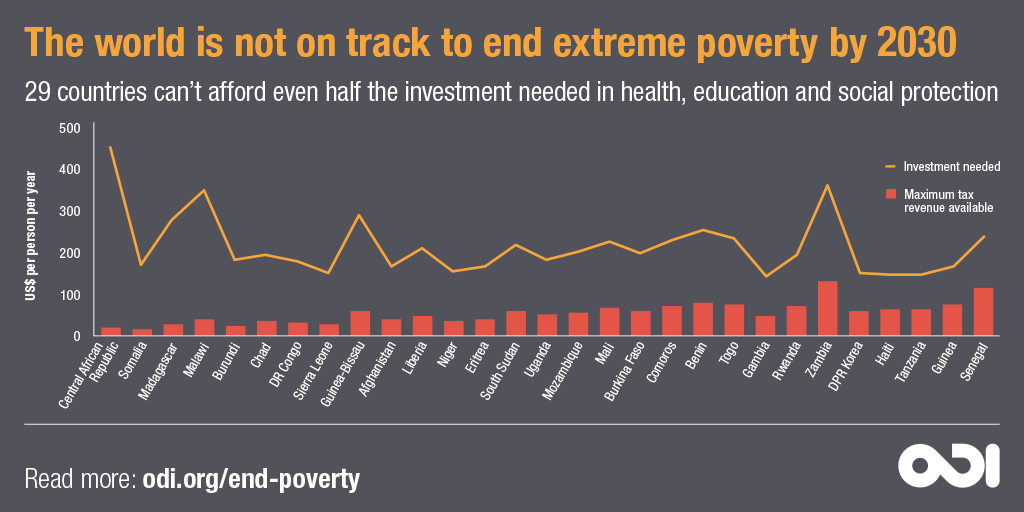With leaders in New York this week for the UN General Assembly, I was encouraged to see that the heads of three major multilateral institutions all sounded the alarm – during the very first day of proceedings – that aid needs to be better targeted towards the poorest.
In a sign of growing momentum, IMF head Christine Lagarde, World Bank CEO Kristalina Georgieva, and Charlotte Petri Gornitzka, Chair of the OECD Development Assistance Committee (DAC), all made this same call to action.
This recognition at the highest level may be the first step toward redistributing aid to the countries least able to finance the end of extreme poverty themselves.
Growing evidence of the need to prioritise the poorest
The challenge of reaching the poorest is becoming clearer. Latest World Bank figures show the rate of poverty reduction is slowing, while ODI projections show the world is massively off track for ending extreme poverty by 2030 – by 400 million people.
85% of these live in fragile states. And half live in 29 countries that can’t afford even half the investment needed in education, health and social protection to end extreme poverty – even if they maximise both the tax they raise and the amount they allocate to the social sectors. While low- and middle-income countries (LICs and MICs) could raise an additional $2 trillion in taxation, 99% of this would be generated by MICs.
Yet tragically, aid is poorly targeted to meet the needs of the poorest. At our event last week, DAC Chair Charlotte Petri Gornitzka noted that philanthropy is focused on middle-income countries rather than taking the risks in the most difficult places, and argued that aid ‘should be targeted to the most difficult places and most at risk of being left behind’.
The numbers back this up. An earlier ODI report also showed that MICs receive 98% of the private infrastructure finance mobilised in the last decade. The typical LIC now receives ten times less aid, per person in extreme poverty, than a typical MIC.
And however you look at – the share of aid to the least developed countries (LDCs), the mean amount of aid per person in extreme poverty, or ODI’s new index for measuring donor efficiency – it is clear that share of aid going to the poorest countries is declining.
But donor countries can fill the financing gap. If they targeted half their aid at LDCs, and met the commitment to provide 0.7% of gross national income in aid, then all countries could afford to end extreme poverty.
The three leaders’ call to action at the UN General Assembly
In view of this evidence, it’s promising that three key leaders made the same call to action yesterday.
First, during ODI’s breakfast meeting, Charlotte Petri Gornitzka repeated her call for better targeting and more aid.
.@CharlottePetriG welcomes @ODIdev research and challenge to donors - need to target #ODA where private flows won’t reach to #EndPoverty pic.twitter.com/p9QbOyjN5K— David Watson (@davidwatson_m) September 24, 2018As we were finishing breakfast we learnt that IMF head Christine Lagarde had just published similar concerns. Her blog argued that ‘boosting tax revenues ... will not be sufficient to meet the financing needs of most low-income developing countries’ and that fiscal space was limited as ‘forty percent of low- income developing countries are now assessed by the IMF and World Bank to be at high risk of debt distress or in debt distress’ (an issue that an upcoming conference at ODI will tackle).
In the afternoon I then heard her provide the keynote opening address at the UN Secretary-General’s high-level meeting on financing the 2030 agenda, where she repeated her call:
Advanced economies can do more, including by moving towards 0.7% of gross national income in aid—and can also better target their aid budgets to support countries most in need of such assistance.Christine Lagarde, Managing Director, IMF
Then, at the end of the high-level meeting, World Bank CEO Kristalina Georgieva made a passionate call for the world ‘to strive for one of the SDGs, to raise money and focus it on the core of the SDGs – end poverty.’
I don’t want to overstate the significance of these pronouncements – or underestimate the challenge of turning them into action. There is still a long way to go before the global narrative changes and donors adjust their policies; longer still before this has an impact in the poorest countries.
But at the highest level of the UN General Assembly, there is now at least the recognition that the world needs to rethink and start prioritising its aid efforts towards the poorest.

